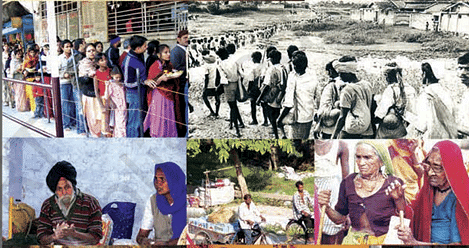Humanities/Arts Exam > Humanities/Arts Notes > Chapter Notes for Humanities > Revision Notes - Introducing Indian Society
Introducing Indian Society Revision Notes | Chapter Notes for Humanities - Humanities/Arts PDF Download
Overview
The chapter "Introducing Indian Society" outlines the basics of sociology, emphasizing the need to unlearn biased and incomplete societal knowledge gained through personal experiences. It introduces self-reflexivity, enabling individuals to critically view themselves within larger societal contexts. This chapter serves as a foundational introduction to deeper discussions on the relationship between individual experiences and broader social structures in the book.

Facts that Matter
- Prior knowledge or familiarity with society is both an advantage and a disadvantage for sociology, the discipline that studies society.
- The advantage is that students are generally not afraid of Sociology—they feel that it can't be a very hard subject to learn.
- The disadvantage is that this prior knowledge can be a problem. In order to learn Sociology, we need to "unlearn" what we already know about society.
- Sociology offers to teach us how to see the world from many vantage points—not just our own, but also that of others unlike ourselves.
- Understanding Indian society and its structure provide a sort of social map on which you could locate yourself, like with a geographical map, locating oneself on a social map.
- Sociology can do more than simply help to locate you or others in this simple sense of describing the places of different social groups.
- Sociology can help to map the links and connections between "personal troubles" and "social issues".
- By personal troubles Mills means the kinds of individual worries, problems or concerns that everyone has.
- The "generation gap" or friction between older and younger generations is a social phenomenon, common to many societies and many time periods.
- Unemployment or the effects of a changing occupational structure is also a societal issue that concerns millions of different kinds of people.
- A sociological perspective teaches you how to draw social maps.
- The economic, political and administrative unification of India under colonial rule was achieved at great expense.
- Colonial exploitation and domination scarred Indian society in many ways.
- But paradoxically, colonialism also gave birth to its own enemy—nationalism.
- Historically, an Indian nationalism took shape under British colonialism.
- The shared experience of colonial domination helped unify and energize different sections of the community.
- Colonialism created new classes and communities which came to play significant roles in subsequent history.
- Indian society is a pluralistic society.
- Indian society is moving towards modernization, full of diversities of language, region, religion, caste, and customs.
- The main values of Indian modernization model are—Socialism, Imperialism, Nationalism, Secularism, Industrialism, Democracy, Individual Freedom, and Fundamental Rights.
- The establishment of democracy in India that rests on the principles of equality, freedom and universal franchise, changed the traditional structure of Indian society.
- A new awareness had emerged during the colonial period itself.
- During this period while all Indians came together for a common cause, various social, economic, political, and administrative changes took place as a result of modernization and capitalistic forces.
- Various processes of change got activated during the British period.
- Some of these processes were completely external while some were internal.
- The external processes include Westernization, Modernization, Secularization, Industrialization, and others; while Sanskritization and Urbanization were internal processes.
- The inception of modernization and westernization is the consequence of our contact with Britain.
- Mechanical techniques in production, the market system in trade, development of means of transport and communication, the concept of civil service based on bureaucracy, formal and written law, modern military organization and trained separate legal system, and modern formal education system were important steps that prepared the background for modernization.
- British colonialists were taking steps to protect their own interests.
- Tradition and modernity in Indian society caused various problems.
- Raja Ram Mohan Roy, Ishwar Chandra Vidyasagar, Keshav Chandra Sen, Dayanand Saraswati, Ranade, Tilak, and Gandhi are some of the prominent names associated with the reform movement to eradicate social evils like Sati System, Restrictions of Widow Remarriage, and Untouchability.
- Since sociology in India had not developed systematically at that time, they portrayed the Indian villages from the British point of view of British policies.
- Villages are the pillars of Indian society and Indian culture.
- For the same reason, even the East India Company had considered the study of Indian villages.
- The first study of Indian society was presented by B H Baden Powell in 1892 in his book, The Indian Village Community.
- After World War I, the poverty in Indian villages and the Indian national movement for freedom also attracted the attention of many scholars towards the villages.
- Sir Charles Metcalfe, Sir George Woodward, Baden Powell, and Francis Buchanan prepared a detailed report after conducting a study and survey of various villages and cities of Madras, Mysore, Bihar, etc. on behalf of the East India Company.
- Subsequently, Herbert Risley, D Abbatson, C B Lucas, W George Briggs, and William Crook tried to understand the Indian rural problems.
- The middle class emerged after receiving western education and the same middle class challenged the colonial rule.
- Various social and cultural communities were organized at the regional and national levels that tried to save the Indian culture and traditions.
- Because of colonialism new classes and communities emerged that played an important role in history later on.
- The urban middle class sounded the bugle of nationalism and initiated the movement of India's freedom.
- Sociology teaches self-reflexivity viz. an ability to reflect upon yourself to turn back or do introspection.
- It should be quick to criticize and slow to praise oneself.
- A comparable social map understood through introspection tells one's location in society.
- Sociology tells kinds of groups or grouping existed in society in its wider import i.e. nation, relationships to each other and it's meaning in terms of one's own life.
- Sociology helps in mapping the links and connections between personal troubles and social issues.
- Personal troubles consist of individual worries, problems or concerns while social issues consist generation gap, unemployment. Communalism, casteism, gender inequalities, etc.
The document Introducing Indian Society Revision Notes | Chapter Notes for Humanities - Humanities/Arts is a part of the Humanities/Arts Course Chapter Notes for Humanities.
All you need of Humanities/Arts at this link: Humanities/Arts
FAQs on Introducing Indian Society Revision Notes - Chapter Notes for Humanities - Humanities/Arts
| 1. What are some key features of Indian society? |  |
Ans. Some key features of Indian society include its diversity in terms of languages, religions, cultures, and traditions, the caste system, joint family system, importance of rituals and festivals, and the influence of modernization and globalization.
| 2. How does the caste system impact Indian society? |  |
Ans. The caste system in Indian society is a social hierarchy that influences various aspects of life including marriage, occupation, social status, and relationships. It can lead to discrimination, inequality, and limited opportunities for individuals belonging to lower castes.
| 3. What role do rituals and festivals play in Indian society? |  |
Ans. Rituals and festivals are an integral part of Indian society as they hold cultural and religious significance. They bring people together, strengthen family bonds, and provide a sense of identity and belonging. They also serve as a way to pass down traditions from one generation to the next.
| 4. How has modernization and globalization impacted Indian society? |  |
Ans. Modernization and globalization have brought about significant changes in Indian society by influencing lifestyle choices, consumption patterns, values, and beliefs. They have led to the adoption of new technologies, ideas, and practices, while also posing challenges such as cultural erosion and social inequalities.
| 5. What are some challenges faced by Indian society in the contemporary world? |  |
Ans. Some challenges faced by Indian society in the contemporary world include issues related to poverty, unemployment, gender inequality, religious conflicts, environmental degradation, and rapid urbanization. These challenges require collective efforts and innovative solutions to address them effectively.
Related Searches






















